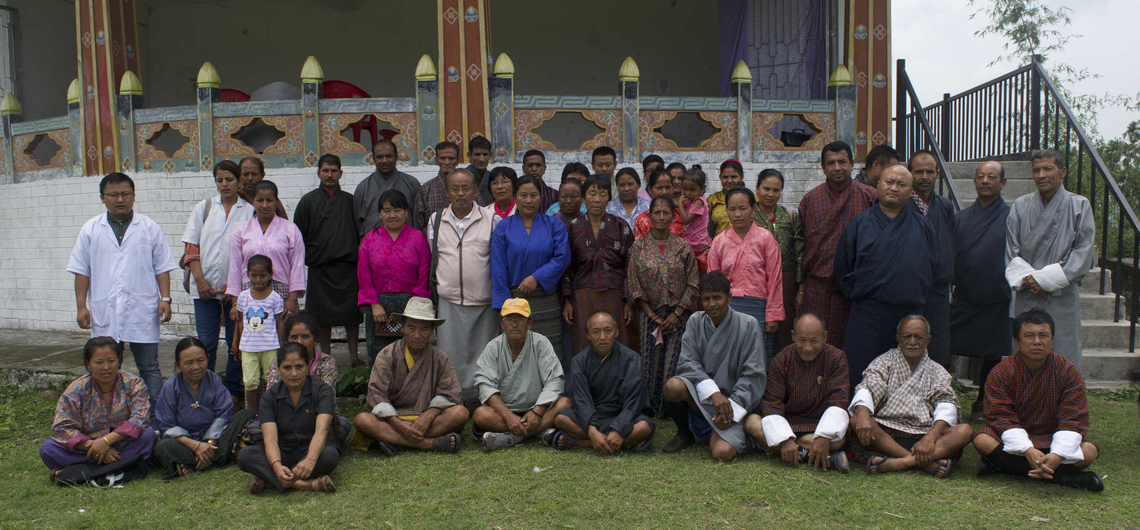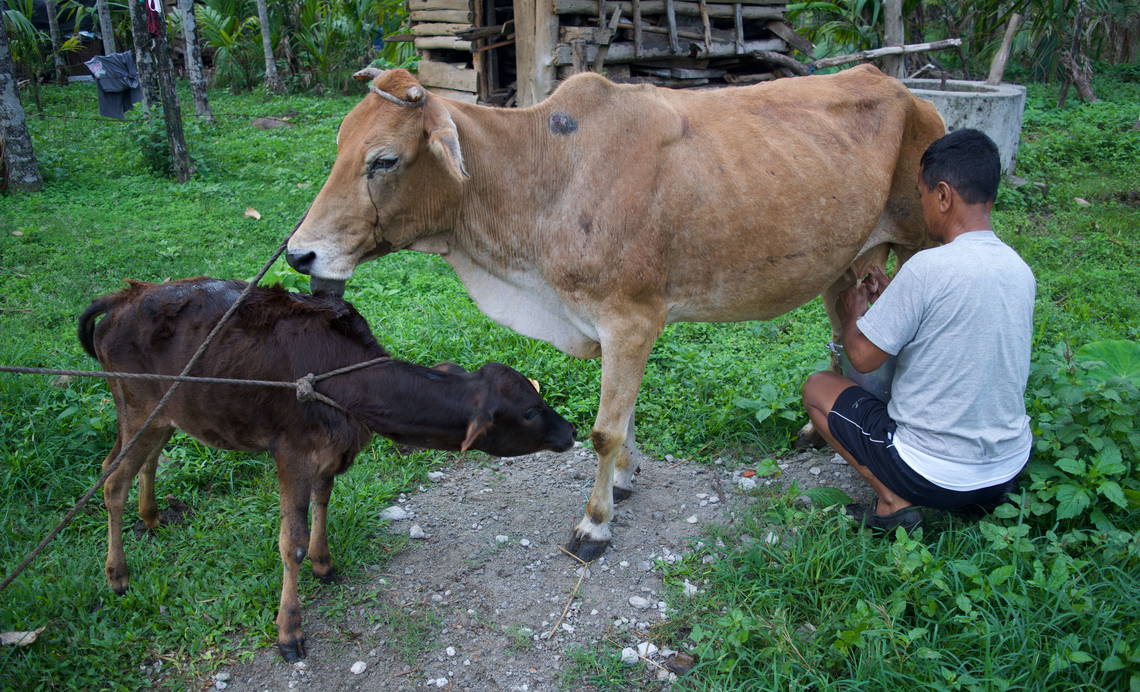Bhutan
Bhutan, a small Himalayan Kingdom located between China to the north and India to the south, is recognized as a leader in implementing the One Health approach to tackle emerging human, animal and environmental health issues. Dr Cork has had over 20 years of experience working with colleagues in Bhutan and spent 6 months in 2014 working at the National Centre for Animal Health (NCAH) as part of her sabbatical.
Currently UCVM faculty members Dr Susan Cork and Dr David Hall lead research work with Bhutan. The program has three priority areas:
- Research and graduate education, through which Bhutanese graduate students participate in graduate training with UCVM supervisors;
- Capacity development, through government collaborations; and
- Community engagement in research and capacity development projects, through outreach and feedback.
Foreign leads: Dr. Sithar Dorjee, Khesar Gyalpo University of Medical Sciences of Bhutan
Other collaborators: Dr. R B Gurung, Director, National Centre for Animal Health, Bhutan
Funding: Start up grants, Internal & external scholarship competitions, University of Calgary International
Major accomplishments to date:
- Three graduate students have been recruited from Bhutan with two (Dr Sangay Rinchen and Dr Jamyang Namgyal completing their MSc programs in 2017 and 2020 respectively. Dr Karma Phuntsho is currently completing his MSc.
- Developed a collaborative international one-health project for the prevention and control of rabies in cattle in Bhutan (Dr Sangay Rinchen, Dr Cork, Dr Hall., Dr Tenzin, Dr Dukpa). This engaged colleagues from Bhutan’s Ministry of Agriculture & Forests and the National Centre for Animal Health (NCAH). Dr Kinzang Dukpa and Dr Tenzin also had the opportunity to visit the University of Calgary and gave presentations on their work on rabies prevention and control in dogs using the One Health approach in Bhutan.
- Developed a collaborative international one-health team to develop plans for the prevention and control of vector borne diseases in Bhutan (Dr Jamyang Namgyal., Dr Cork., Dr Tim Lysyk., Dr Sithar Dorjee) This also engaged members from Bhutan (National Centre for Animal Health (NCAH), Ministry of Agriculture & Forests, University of Medical Sciences, and Royal Centre for Disease Control (RCDC). A technical training workshop and joint seminar were hosted by team members in September 2019. Data from ticks collected from 2 districts in eastern Bhutan informed the training workshop and provided guidelines for on-going tick collection in Bhutan. Modeling of tick habitat suitability was also completed and shared with collaborators in Bhutan.

Rabies research in Bhutan (Dr Sangay Rinchen)
Dr Sangay Rinchen, a senior veterinarian, is currently the Head of Disease Prevention and Control at NCAH, Thimphu Bhutan. Dr. Rinchen’s MSc. program focussed on exploring options to prevent rabies in cattle in Bhutan. Rabies remains a significant public health concern in Bhutan and also threatens the livelihood of marginal cattle farmers in southern parts of Bhutan. The occurrence of rabies infection in humans, cattle and other livestock species is attributed to the cross border movement of rabid dogs from endemic areas on the border with India.
Project Details & Outcomes
In his MSc. program, Dr. Rinchen explored the options to prevent rabies in cattle in the rabies endemic areas of Bhutan. The following are the key outcomes of his MSc. project:
- Assessed the knowledge, attitudes and practices of cattle owners in the rabies endemic and non-endemic areas of Bhutan
- Conducted a benefit cost ratio assessment to explore the option of vaccinating cattle against rabies in the rabies endemic areas of Bhutan
- Assessed the risk of rabies re-introduction into rabies free areas of Bhutan
The outcomes of the project have been instrumental in designing rabies educational programs for cattle owners and people residing in the rabies endemic areas of Bhutan and also for strengthening disease surveillance and risk mitigation measures to prevent rabies reintroduction into rabies free areas. The project brought together multiple stakeholders, including farmers, within Bhutan to work closely, along with teams responsible for dog rabies prevention, to achieve rabies elimination from Bhutan.

Dr. Sangay Rinchen

Dr. Rinchen with the cattle owners in one of the rabies endemic areas of Bhutan

A small-scale cattle farmer milking his cow
See the following articles for more information:
- Rinchen, S., Tenzin, T., Gurung, R.B., Rinzin, K., Cork, S. (2021)
One Health in Policy Development: Options to Prevent Rabies in Cattle in Bhutan. Chapter 29 In One Health: the theory and practice of integrated health approaches; Eds Zinsstag, J., Schelling, E., Crump, L., Whittaker, H., Tanner, M., Stephen, C. CABI.
https://www.cabi.org/cabebooks/ebook/20203439975 - A Community-Based Knowledge, Attitude, and Practice Survey on Rabies Among Cattle Owners in Selected Areas of Bhutan https://journals.plos.org/plosntds/article?id=10.1371/journal.pntd.0007305
- A Qualitative Risk Assessment of Rabies Reintroduction into the Rabies Low-Risk Zone of Bhutan https://www.frontiersin.org/articles/10.3389/fvets.2020.00366/full
Tick study in Eastern Bhutan (Dr Jamyang Namgyal)
Dr. Jamyang Namgyal is a Senior Veterinary Officer with the Royal Government of Bhutan. He recently completed his masters (September 2020) under the supervision of Dr. Susan Cork, Department of Ecosystem and Public Health, Faculty of Veterinary Medicine, University of Calgary. Jamyang’s MSc program, including the fieldwork in Eastern Bhutan, was funded by a One Health Graduate Training Award and a UCalgary International Grant. The Department of Livestock, Ministry of Agriculture and Forests, Royal Government of Bhutan provided ‘in kind’ support for the fieldwork in Bhutan. His MSc thesis titled “Identification and Distribution of Tick Species in Cattle in Eastern Bhutan” is currently available in the Vault of University of Calgary (http://hdl.handle.net/1880/112725).
His MSc research program is another of the success stories for the University of Calgary, Faculty of Veterinary Medicine’s internationalization program and engaged a broad supervisory team including colleagues from the Royal Government of Bhutan, the Canadian Food Inspection Agency, Agriculture and Agri-Food Canada and the BC –CDC as well as academics within Canada and Bhutan. Jamyang’s MSc program is a good example of a successful One Health project and established institutional collaborations between Bhutan and Canada. Learn more
Dr. Namgyal’s MSc program strengthened institutional collaborations between Bhutan and Canada. The following are key outcomes of Dr. Namgyal’s MSc research program:
- Determined the presence, diversity and infestation prevalence of tick species in cattle in two districts of eastern Bhutan using a targeted field survey.
- Modeled the distribution of selected tick species identified in eastern Bhutan under current environmental conditions using MaxEnt to determine potential habitat suitability.
- Assessed the knowledge, attitude, and practices (KAP) about ticks and tick-borne diseases (TBDs) among cattle owners in a selected cattle farming area in eastern Bhutan by engaging community members directly and in doing so has already raised awareness about ticks and tick-borne diseases.
- Conducted a qualitative risk assessment for the introduction of Crimean-Congo haemorrhagic fever (CCHF) into Bhutan as a part of directed study.
The outcomes of this study provide information which provides the foundation to initiate a targeted tick control program and to plan tick surveillance and subsequent prevention and control programs for tick-borne diseases in cattle in Bhutan.
- Jamyang Namgyal, Tenzin Tenzin, Sylvia Checkley, Tim J. Lysyk, Sangay Rinchen, Ratna B. Gurung, Sithar Dorjee, Isabelle Couloigner, Susan C. Cork (2021) A knowledge, attitude, and practices study on ticks and tick-borne diseases in cattle among farmers in a selected area of eastern Bhutan. PLoS ONE 16(2):e0247302. DOI: 10.1371/journal.pone.0247302
- Jamyang Namgyal, Tim J. Lysyk, Isabelle Couloigner, Sylvia Checkley, Ratna B. Gurung, Tenzin Tenzin, Sithar Dorjee, Susan C. Cork (2021): Identification, distribution, and habitat suitability models of ixodid tick species in cattle in eastern Bhutan. Tropical Medicine and Infectious Disease, 6(1):27.DOI: 10.3390/tropicalmed6010027
- Namgyal, J.; Couloigner, I.; Lysyk, T.J.; Dergousoff, S.J.; Cork, S.C (2020). Comparison of Habitat Suitability Models for Haemaphysalis longicornis Neumann in North America to Determine Its Potential Geographic Range. Int. J. Environ. Res. Public Health, 17, 8285. https://www.mdpi.com/884510

Dr. Jamyang Namgyal
